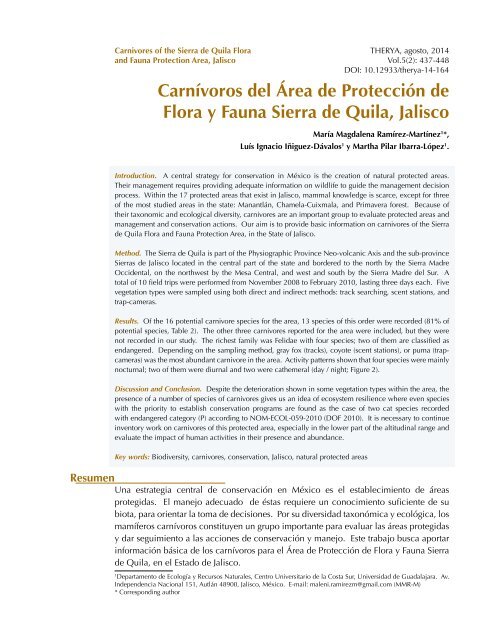therya-5_2
therya-5_2
therya-5_2
Create successful ePaper yourself
Turn your PDF publications into a flip-book with our unique Google optimized e-Paper software.
Carnivores of the Sierra de Quila Flora<br />
and Fauna Protection Area, Jalisco<br />
THERYA, agosto, 2014<br />
Vol.5(2): 437-448<br />
DOI: 10.12933/<strong>therya</strong>-14-164<br />
Carnívoros del Área de Protección de<br />
Flora y Fauna Sierra de Quila, Jalisco<br />
María Magdalena Ramírez-Martínez 1 *,<br />
Luís Ignacio Iñiguez-Dávalos 1 y Martha Pilar Ibarra-López 1 .<br />
Resumen<br />
Introduction. A central strategy for conservation in México is the creation of natural protected areas.<br />
Their management requires providing adequate information on wildlife to guide the management decision<br />
process. Within the 17 protected areas that exist in Jalisco, mammal knowledge is scarce, except for three<br />
of the most studied areas in the state: Manantlán, Chamela-Cuixmala, and Primavera forest. Because of<br />
their taxonomic and ecological diversity, carnivores are an important group to evaluate protected areas and<br />
management and conservation actions. Our aim is to provide basic information on carnivores of the Sierra<br />
de Quila Flora and Fauna Protection Area, in the State of Jalisco.<br />
Method. The Sierra de Quila is part of the Physiographic Province Neo-volcanic Axis and the sub-province<br />
Sierras de Jalisco located in the central part of the state and bordered to the north by the Sierra Madre<br />
Occidental, on the northwest by the Mesa Central, and west and south by the Sierra Madre del Sur. A<br />
total of 10 field trips were performed from November 2008 to February 2010, lasting three days each. Five<br />
vegetation types were sampled using both direct and indirect methods: track searching, scent stations, and<br />
trap-cameras.<br />
Results. Of the 16 potential carnivore species for the area, 13 species of this order were recorded (81% of<br />
potential species, Table 2). The other three carnivores reported for the area were included, but they were<br />
not recorded in our study. The richest family was Felidae with four species; two of them are classified as<br />
endangered. Depending on the sampling method, gray fox (tracks), coyote (scent stations), or puma (trapcameras)<br />
was the most abundant carnivore in the area. Activity patterns shown that four species were mainly<br />
nocturnal; two of them were diurnal and two were cathemeral (day / night; Figure 2).<br />
Discussion and Conclusion. Despite the deterioration shown in some vegetation types within the area, the<br />
presence of a number of species of carnivores gives us an idea of ecosystem resilience where even species<br />
with the priority to establish conservation programs are found as the case of two cat species recorded<br />
with endangered category (P) according to NOM-ECOL-059-2010 (DOF 2010). It is necessary to continue<br />
inventory work on carnivores of this protected area, especially in the lower part of the altitudinal range and<br />
evaluate the impact of human activities in their presence and abundance.<br />
Key words: Biodiversity, carnivores, conservation, Jalisco, natural protected areas<br />
Una estrategia central de conservación en México es el establecimiento de áreas<br />
protegidas. El manejo adecuado de éstas requiere un conocimiento suficiente de su<br />
biota, para orientar la toma de decisiones. Por su diversidad taxonómica y ecológica, los<br />
mamíferos carnívoros constituyen un grupo importante para evaluar las áreas protegidas<br />
y dar seguimiento a las acciones de conservación y manejo. Este trabajo busca aportar<br />
información básica de los carnívoros para el Área de Protección de Flora y Fauna Sierra<br />
de Quila, en el Estado de Jalisco.<br />
1<br />
Departamento de Ecología y Recursos Naturales, Centro Universitario de la Costa Sur, Universidad de Guadalajara. Av.<br />
Independencia Nacional 151, Autlán 48900, Jalisco, México. E-mail: maleni.ramirezm@gmail.com (MMR-M)<br />
* Corresponding author



